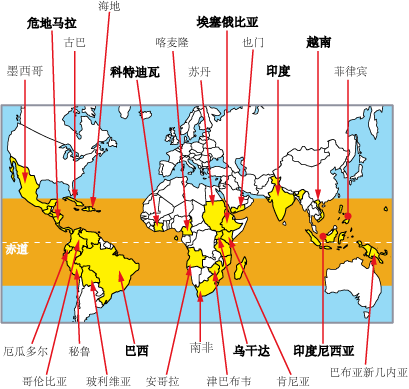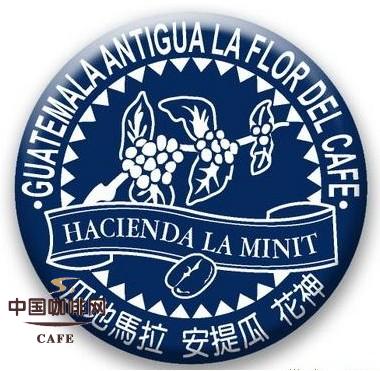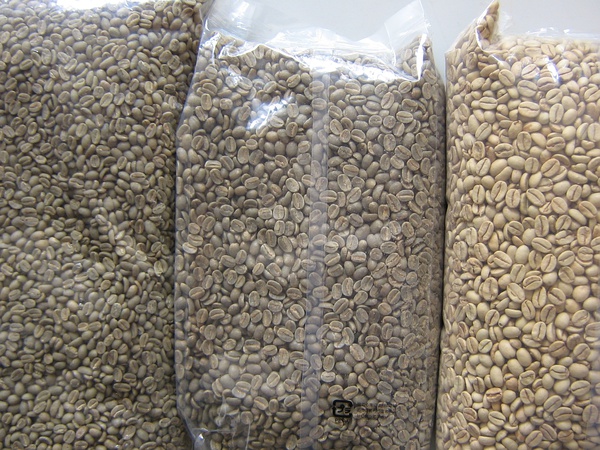Coffee beans the story of coffee beans the origin of coffee beans the story of the shepherd
Coffee beans
In a broad sense, there are two kinds of coffee beans in the world, Arabica beans and Robosta beans. The earliest Arab way to eat coffee was to chew the whole fruit (CoffeeCherry) to absorb its juice. They then mixed the ground coffee beans with animal fat as a physical supplement for long trips, and it was not until about 1000 AD that the green coffee beans were boiled in boiling water to make an aromatic drink. Three centuries later, Arabs began to bake and grind coffee beans. Because drinking was forbidden in the Koran, Arabs consumed a lot of coffee, so religion was actually a big factor in the popularity of coffee in the Arab world.
Origin
The Story of the Shepherd
Legend has it that around the tenth century AD, on the Ethiopian plateau of Africa, there was a shepherd named Karl. One day he suddenly looked excited and excited when he saw the goat. He thought it was strange, and then after careful observation, he found that the sheep were excited after eating some kind of red fruit. Carl tasted some curiously, and found that he was refreshed and excited after eating, so he picked some of the incredible red fruit home and distributed it to the locals, so its magical effect spread.
II. Arab monks
Legend has it that Shek, the chief expelled by his people for crime, was deported from the mountains of Yemen in 1258. Omar, exiled far away.
Vasaba (in Arabia), when he was walking on the mountain exhausted, he found that the birds on the branches made a very sweet cry after pecking at the fruit of the tree. So he boiled the fruit with water, but unexpectedly sent out a rich and attractive fragrance, and the original feeling of exhaustion was eliminated after drinking, full of vitality. Later, Omar collected many of these magical fruits, and when someone got sick, she made the fruit into soup for them to drink, refreshing them. Because he did good everywhere and was loved by believers, his sins were soon forgiven, and when he returned to Mocha, he was revered as a saint for finding this fruit. It is said that the magic cure at that time was coffee. [1]
Four famous beans
It is said that the origin of coffee plant can be traced back to millions of years ago, in fact, the real age when it was discovered can no longer be tested. It is only said that coffee is Ethiopia.
A shepherd named Kaldi in the subhighlands became very lively and energetic when he discovered that his sheep had inadvertently eaten the fruit of a plant. All historians seem to agree that the birthplace of coffee is the Kaffa region of Ethiopia. But the earliest people who planned to grow and eat coffee were Arabs, and the name coffee is thought to come from the Arabic "Qahwah", which means plant drink.
Coffee for drinking is said to have begun at the beginning of the eleventh century, and the record can be seen in ancient Arab documents. Before that, coffee beans were dried and boiled in the Arab region and used as stomach medicine, but it was later learned that coffee also had a refreshing effect, coupled with the strict Muslim commandments that forbade believers from drinking alcohol. Believers drank coffee juice from roasting as an exciting drink instead of alcohol, and it was said that locals knew how to roast raw beans after the 13th century.
In the 16th century, coffee was gradually introduced into Europe through Venice and the port of Marseilles in the name of "Arabian wine". The custom of drinking coffee among Europeans was gradually spread by Italian Venice merchants in doing business in the 17th century, and Europe appeared in Venice.
The first coffee shop-BottegadelCaffe. Over the past 400 years, the drinking habit of coffee has not only spread from the West to the East, but has even become an unstoppable trend.
Coffee was planted in large numbers by Arabs in the 12th and 3rd centuries, and the world's first coffee shop was born in Damascus in the Middle East in the 16th century (1530). In just a few years, there were different numbers of coffee shops in more than 200 cities throughout the empire, from the ancient Constantinople to the Caucasus, from the Persian Gulf to Budapest, and the roads connecting these cities across the desert wilderness were dotted with mobile coffee tents to serve a steady stream of business travelers and troops. Coffee also spread to Europe in the same century, when coffee was taken to western countries with the Turks on a western expedition to Austria. Unexpectedly, it soon captured the hearts of Europeans. According to records, a packet of samples sent from Venice to the Netherlands in 1596 was the earliest coffee bean seen by Europeans north of the Alps. Legend has it that coffee was so rare in Western Europe that at first there was a joke that German housewives used chicken soup to make coffee. According to scholars' speculation, in the booming import and export trade of seasoning raw materials at the end of the 16th century, many coffee beans from the east began to enter Europe through Venice with developed economy and trade.
However, it was not until 1683 that the first coffee shop in Europe was opened by a Polish in Vienna, Austria. Businessmen who are proficient in Eastern European and Turkish languages, led by the brilliant Armenian businessman JohannesDiodato, not only acted as translators and guides for Austria in wartime, but also engaged in the hugely profitable coffee trade on both sides of the line of fire, meeting the needs of their own cafes, while also solving the urgent shortage of raw materials for many aristocratic and wealthy citizens' family salons. Won the attention of the upper echelons. A few years later, the coffee industry, which can be seen everywhere in the streets and alleys, developed rapidly. Most of these cafes were opened by his fellow villagers or Turks from other parts of the Ottoman Turkish Empire, naturally with a strong Middle Eastern flavor. Many street corners float out of the coffee hot smell of the narrow shop, you can also see the Istanbul coffee shop unique wall bench, open firewood coffee stove Most of the guests come from vendors, craftsmen and craftsmen who make a living in a nearby market.
Today, people are familiar with, or imagine elegant, comfortable, pure European-style cafes with an open social salon atmosphere, will have to wait for about 50 years, until the Enlightenment era of the general awakening of civic consciousness. before it really began to take to the center of life in Vienna and other Western cities.
Technically, it's just a small, simple coffee shop. At that time, people in the middle and upper classes were still intoxicated in the closed private coffee circle in their homes, and the free citizen class, which was keen on the initial economic success, had not yet become a force to influence the social and political society.
Coffee beans details:
Country: Costa Rica
Grade: SHB
Producing area: Tarazhu
Producer: Tarazhu local small farmers
Treatment: washing
Variety: Kaddura, Kaduai
Manor: Diamond Hill Manor
Flavor: soft orange notes, toast, caramel sweet, clean taste

Important Notice :
前街咖啡 FrontStreet Coffee has moved to new addredd:
FrontStreet Coffee Address: 315,Donghua East Road,GuangZhou
Tel:020 38364473
- Prev

Guatemala Antigua Coffee Culture Guatemala's most expensive Coffee Buck Antigua Coffee
Coffee was really introduced into Guatemala in 1750 by Father Jesuit, where the coffee industry was developed by German colonists at the end of the 19th century. Today, most of the coffee industry's production takes place in the south of the country. There are seven main coffee producing areas in Guatemala: Antigua, Coban, Atitlan and Huehuete.
- Next

Pico / Guatemala / Coffee beans / Vivetna Fruit is located in Guatemala
Vivette Nango, located in the most remote northwest highlands of Guatemala, is the driest and highest coffee area in Guatemala, thanks to the hot air from the Tiwantipe Plain in Mexico, making this area high and not cold. The coffee flavor in this area is typical of very hard beans, with lively and bright sour fruit, sour grapefruit, raspberry and mellow thickness. Viv.
Related
- Does Rose Summer choose Blue, Green or Red? Detailed explanation of Rose Summer Coffee plots and Classification in Panamanian Jade Manor
- What is the difference between the origin, producing area, processing plant, cooperative and manor of coffee beans?
- How fine does the espresso powder fit? how to grind the espresso?
- Sca coffee roasting degree color card coffee roasting degree 8 roasting color values what do you mean?
- The practice of lattes: how to make lattes at home
- Introduction to Indonesian Fine Coffee beans-- Java Coffee producing area of Indonesian Arabica Coffee
- How much will the flavor of light and medium roasted rose summer be expressed? What baking level is rose summer suitable for?
- Introduction to the characteristics of washing, sun-drying or wet-planing coffee commonly used in Mantenin, Indonesia
- Price characteristics of Arabica Coffee Bean Starbucks introduction to Manning Coffee Bean Taste producing area Variety Manor
- What is the authentic Yega flavor? What are the flavor characteristics of the really excellent Yejasuffi coffee beans?

